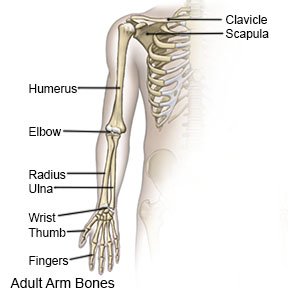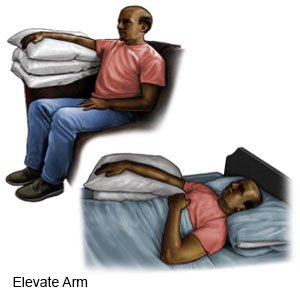Elbow Fracture
Medically reviewed by Drugs.com. Last updated on Apr 6, 2025.
AMBULATORY CARE:
An elbow fracture
is a break in one or more of the 3 bones that form your elbow joint. Osteoporosis (brittle bones) can increase your risk for an elbow fracture.
 |
Common signs and symptoms include the following:
- Pain and tenderness
- Swelling and bruising
- Trouble moving your arm or not being able to move your arm at all
- Weakness or numbness in your elbow, arm, or hand
- Deformity (your arm is shaped differently than normal)
Seek care immediately if:
- Your skin becomes swollen, cold, or pale.
- Your elbow, hand, or fingers are numb.
Call your doctor if:
- You have a fever.
- The pain gets worse, even after you rest and take your medicine.
- You have new or more trouble moving your arm.
- You have new sores around the area of your brace, splint, or cast.
- Your brace, splint, or cast becomes damaged.
- You have questions or concerns about your condition or care.
Treatment for an elbow fracture
may include any of the following:
- Prescription pain medicine may be given. Ask your healthcare provider how to take this medicine safely. Some prescription pain medicines contain acetaminophen. Do not take other medicines that contain acetaminophen without talking to your healthcare provider. Too much acetaminophen may cause liver damage. Prescription pain medicine may cause constipation. Ask your healthcare provider how to prevent or treat constipation.
- NSAIDs , such as ibuprofen, help decrease swelling, pain, and fever. This medicine is available with or without a doctor's order. NSAIDs can cause stomach bleeding or kidney problems in certain people. If you take blood thinner medicine, always ask your healthcare provider if NSAIDs are safe for you. Always read the medicine label and follow directions.
- A device such as a brace, cast, sling, or splint may be put on your elbow to limit your arm movement. The device will hold the broken bones in place while they heal, help decrease pain, and prevent more damage.
- Ultrasound therapy directs sound waves into your elbow. The sound waves help the bones heal.
- Surgery may be needed to hold bones in their normal position with pins, wires, or screws. Surgery may also be done if you have other injuries, such as nerve or blood vessel damage.
Self-care:
- Elevate your elbow above the level of your heart as often as you can. This will help decrease swelling and pain. Prop your elbow on pillows or blankets to keep it elevated comfortably. While your elbow is elevated, wiggle your fingers and open and close them to prevent hand stiffness.

- Apply ice on your elbow on your elbow for 15 to 20 minutes every hour or as directed. Use an ice pack, or put crushed ice in a plastic bag. Cover it with a towel. Ice helps prevent tissue damage and decreases swelling and pain.
- Go to physical therapy as directed. A physical therapist can teach you exercises to help improve movement and strength and to decrease pain.
Care for your brace, cast, or splint:
Follow instructions about when you may take a bath or shower. It is important not to get your brace, cast, or splint wet. Cover your device with a plastic bag before you bathe. Tape the bag to your skin above the device to help keep out water. Hold your elbow away from the water in case the bag breaks.
- Check the skin around your cast, brace, or splint daily for any redness or open skin.
- Do not use a sharp or pointed object to scratch your skin under the cast, brace, or splint.
- Do not remove your brace or splint unless directed.
Follow up with your doctor as directed:
You may need to see a specialist. You may need more x-rays and treatment. Write down your questions so you remember to ask them during your visits.
© Copyright Merative 2025 Information is for End User's use only and may not be sold, redistributed or otherwise used for commercial purposes.
The above information is an educational aid only. It is not intended as medical advice for individual conditions or treatments. Talk to your doctor, nurse or pharmacist before following any medical regimen to see if it is safe and effective for you.
Further information
Always consult your healthcare provider to ensure the information displayed on this page applies to your personal circumstances.
